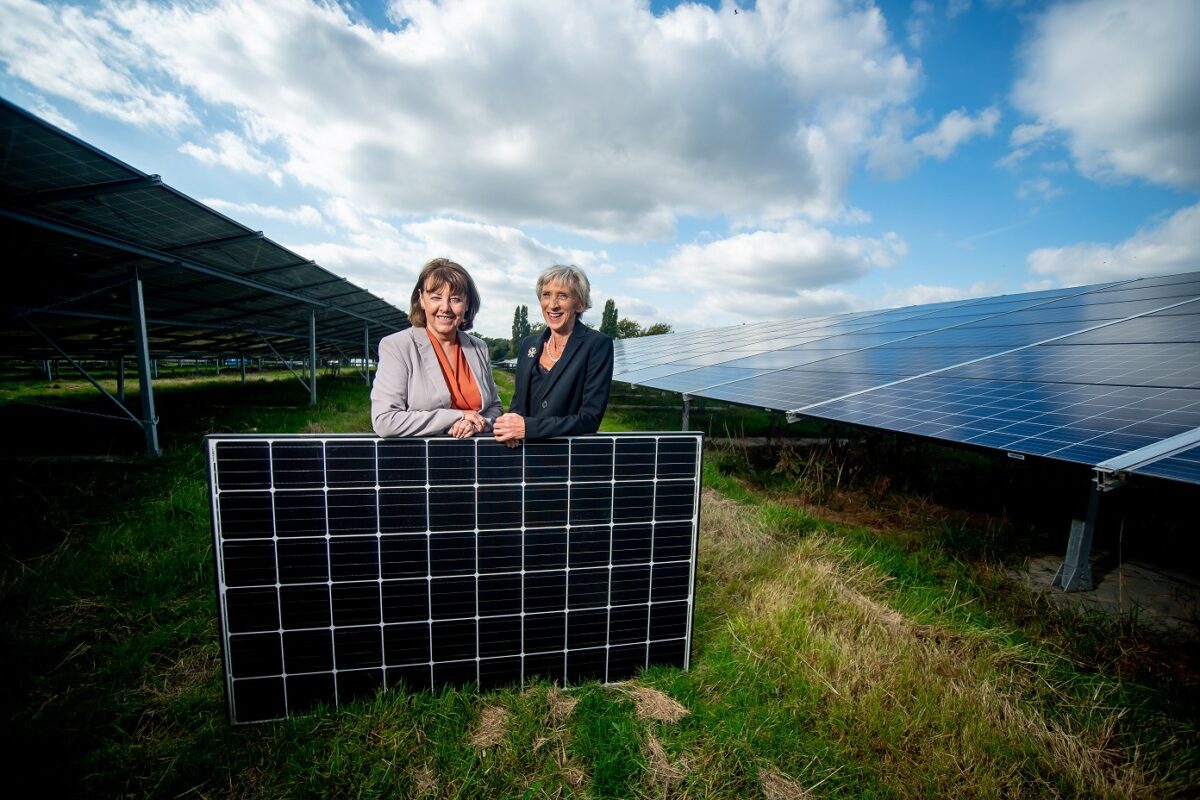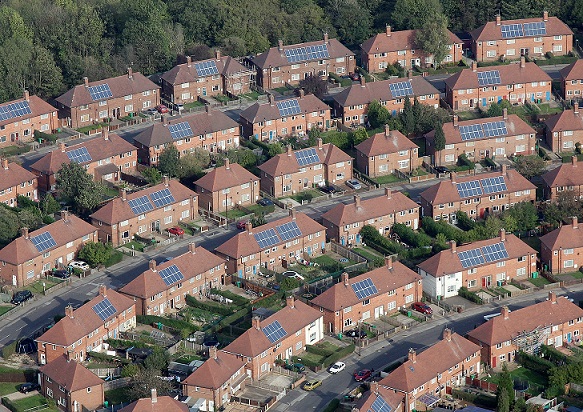Since Anesco announced with fanfare the completion of the UK’s first subsidy-free solar farm in September last year, many eyes have been trained on the solar sector to see who would be next to achieve what has so far proved elusive to many developers.
While Anesco had said it would follow Clay Hill with as many as five further sites, the 10MW solar farm with a 6MW battery has yet to be repeated by the company, while others are likely to bring theirs forward next year.
It was therefore unexpected when the UK’s second subsidy-free site was revealed last month, not by an experienced developer utilising supply chain relationships and revenue modelling to land on an economic model that worked, but by a local authority utilising its own unique position to build out a site.
As reported by Solar Power Portal last month, the Westhampnett solar plus storage site was commissioned in mid-October, combining 7.4MW of solar using panels from Hanwha Q Cells, with a 4.4MW/4.06MWh Tesvolt battery storage, and solar and battery inverters from SMA.
Despite a 10 week set back after the company’s principal contractor Carillion went under, the project was picked up by Arun Construction – already involved as designer of the PV and battery scheme – and completed alongside Smith Brothers, which was contracted by West Sussex County Council to connect the Westhampnett solar farm to the electricity distribution network.
It will make its money for the council in four principle areas, beginning with the generation from the solar farm which will be repurchased from Your Energy Sussex, a council-backed energy supplier set up in 2014. This will be used to power the local authority’s operations, while some will also be used to charge the battery.
This will be combined with grid power purchased during periods of low pricing to be sold back at times of demand under an arbitrage model. The battery will also be used to provide Triad avoidance and deliver capacity market contracts, while a demand side response agreement has also been secured with nPower which will use the battery to access the grid services market.
This follows the general trend for battery projects and is expected to make multi-million pound income over 20 years, but it is this timeframe that separates the project from those that could follow it.

“I’m immensely proud of this scheme”: Louise Goldsmith (right), leader of West Sussex County Council, and Councillor Deborah Urquhart (left) cabinet member for environment at the subsidy free Westhampnett solar-plus-storage farm. Image: West Sussex County Council.
This was remarked upon by Finlay Colville, head of market research at SPP’s publisher Solar Media, in his recent blog, who essentially discounted the significance of the project in his analysis of how subsidy-free solar farms are to be built up in the coming years.
“Are we really to believe that a local council (not entities known for their supreme fiscal prudence) is going to be front-runner in UK large-scale post-subsidy build-outs! The Westhampnett site had been in the planning for several years, and was fundamentally an exercise in sustainability-target driven marketing euphoria.”
Including Anesco’s site, he went on: “In isolation, neither of the above sites would likely have passed any due-diligence analysis by an external investor, and should not be considered for inclusion in a discussion of how the UK has reacted to the removal of FiTs, ROCs and CfD incentive mechanisms for solar sites in recent years.”
Far be it from me to dispute Mr. Colville’s comments – which are far more informed than my own – however there is something to be said on the external investor comparison; does it need apply?
Public bodies versus external investors
As Westhampnett’s project lead and senior advisor to West Sussex County Council, Tom Coates, told SPP: “You'll struggle to find investors that would be investing in battery schemes of a significant size because the returns aren't guaranteed to be within ten years or whatever an investor will be looking to get.
“Local authorities are well placed in that regard because they're not going anywhere as entities so that stands aside from the commercial developer model. The ability and the will to play the slightly longer game is significant.”
This was supported by Christian Went, key account manager at Tesvolt, who added: “Public bodies don’t think in financial quarters like other investors. A storage system with a service life of 30 calendar years, as ours has, is ideal to meet the requirements for a solution which serves tax payers in the long term.”
So yes, Westhampnett does not offer too many applicable lessons for the normal players in the UK solar market who do not have access to ownership over a 35-acre former landfill, or the patience to wait 20+ years for their money. But these are the people still struggling to put a business case together, while councils like that in West Sussex are able to utilise their resources and crack on with projects – providing lessons for other councils to follow.
To discount them from any analysis of the UK’s future in solar could therefore be considered a slight oversight of the work they are carrying out, particularly in a year when a new local authority category was announced for future Solar Power Portal and Energy Storage News Awards, named after the late councillor Alan Clark who worked tirelessly to develop solar projects in Nottingham that only a council could have carried out.

Image: Nottingham City Council.
Councils are doing it for themselves
As Colville stated, councils are fiscally shy – not least as a result of continued cuts to central funding – and so for a local authority like West Sussex County Council (and a Conservative one at that) to take on solar and storage shows the level of confidence in the technology for its economic, as well as, environmental benefits.
But as council leader Louise Goldsmith told SPP, councils can look in their own jurisdictions to see if such an opportunity is available to them.
“To be really effective on sustainable energy you need to look what's in your back yard so although we're the second wooded county, we're also the sunniest county in the country so why wouldn't you look at investing and developing local energy? Not only is it green and clean which is very important, it actually feeds into the grid and the country needs energy,” she said.
“As the business case stacks up and gives us the revenue, and in this case on land that was going not to be used for 20 years, why wouldn't we invest in that?”
The 'why' for the external investors Colville’s blog was concerned with is around this timeframe, and the fact that there remains more risk than many are comfortable with having had a decade of government-backed subsidy payments to rely on. Accusations of laziness have been levelled at the investment community as a result, but it can hardly be said that councils do not also face some concerns over their investment decisions – maybe even more so as a public body.
“We did have additional scrutiny, there's no question,” Coates said.
“The income being derived from the batteries is less but we've always been upfront about it in that there is additional risk there in terms of it not being a feed-in tariff comparable income stream, however the income could be significantly more than we've profiled. The opportunities around in the market have inherent risk but having said that, we had additional scrutiny and it was positive by the end of it.
“Even with all the challenges we've had with Westhampnett there is significant appetite here for other investment in other sites.”
Goldsmith added: “If we've got more landfill sites and they are suitable and we can plug the energy in [then] yes, we'll be looking at other sites. We have another one coming up which we hope we will be developing out shortly.”
This ‘other one’ is a 36MW battery being planned, with the possibility of solar to boot, for another site that only a council could build on. Potential like this is not available to external investors, who of course will be at the forefront of developing subsidy-free propositions well into the future.
But councils are doing it now, playing the role of ‘leading lights’ in UK solar, and will no doubt continue to do so, building out projects that no one else could, adding a touch of the personal to what investors no doubt see now as a financial and economic problem to crack.
Goldsmith said: “It's a big deal for me and the council, I'm immensely proud of this project and it's very near to my heart,” – I can’t wait for such sentiments to come out of the investment community in the UK’s subsidy-free future.
